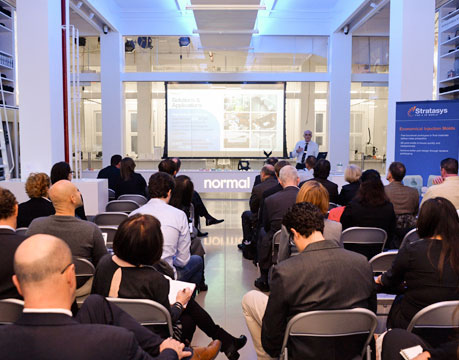5 Questions with Stratasys CEO David Reis
5 Questions with Stratasys CEO David Reis


David Reis, the CEO of Stratasys, speaking at a media event held recently in New York City
The global 3D printing market is expected to grow from $3 billion in 2014 to $21 billion by 2020, according to industry research. As 3D printing continues its exponential growth trajectory, what will be its future impact on industrial manufacturing?
ASME.org caught up with David Reis, CEO of Stratasys, one of the key players in the 3D printing market, at a media event held in New York recently. Reis spoke about the rapid growth of 3D printing and how it enables cost and time savings in manufacturing including industries like industrial, aerospace, automotive, medical devices, and consumer products.
Approximately 80% of fused deposition modeling (FDM) system owners in the U.S. are using the technology in augmented manufacturing for jigs, fixtures, and end-use parts application, said Reis in his presentation. Using 3D printing, “organizations can realize 40-90% reductions in lead times and 70-90% cost savings,” he added.
Listen to the complete interview in the podcast: 3D Printing Advances to Industrial Manufacturing or read an abridged version below.
Q1: 3D printing has been used for prototyping inmanufacturing for almost three decades. Which other areas of industrialmanufacturing is it being used in now?
Reis: The last 30 years since the industry has established, our main focus was rapid prototyping, both for design and functional testing. In the last few years, we have been rapidly penetrating manufacturing in two areas. One of them is in the production of end-use parts, which is basically replacing traditional manufacturing processes, such as injection molding and machining with additive manufacturing. The other space we are penetrating is what we call augmented manufacturing, which is basically the manufacturing of tools that aid the manufacturing process. It could be guides, jigs, and fixtures, which assist people on the manufacturing floor to manufacture products.
Q2: 3D printing has the potentialto disrupt several industries. Is there any application that you think still needs attention and could benefit from additive technology?
Reis: I think there is a great opportunity in the medical space. Already today, there are some companies around the world, which are printing replacement parts for “body” like knees, hips. There are great opportunities, and nevertheless, it will require a lot of research and proof-of-concept in clinical validation of this area.
Q3: There someconcerns about the environmental impact of 3D printed products. What's your opinion on that?
Reis: I think the nature of additive manufacturing is that it’s more friendly to the environment than the traditional manufacturing processes. Most of the traditional manufacturing processes are subtractive, which means you take bulk of plastic and you subtract plastic from it to get the end part. In additive, you are building bottom up, so you are using only the plastic that you need. So by definition, you are using less plastic and the process will be consuming less energy.
Q4: With so many products now being developedusing 3D printing, are standards required?
Reis: The use of additive manufacturing to manufacture products is relatively small but rapidly growing. Most of the use of additive manufacturing today is in rapid prototyping and augmented manufacturing. The production of end-use parts in each industry will require compliance with current standards. A good example could be aerospace. If you want to replace a flying part in the airplane, you have to comply with standards in aerospace. Likewise in medical.
Q5: What is the future outlook for 3D printing and do you think3D printers will someday becomeas common as themicrowave in homes?
Reis: The outlook is great and the projection is that this industry is going to grow dramatically over the coming decade. The numbers are talking of growth from $3-3.5 billion in 2014 to $20 billion in 2020, which is only seven years from now. Whether I think 3D printing will become a household tool for manufacturing parts at home, I am a little bit more pessimistic about it. I think it will take more than a few years to get there, but we might be able to see it 20-30 years from now.
Listen to the podcast: 3D Printing Advances to Industrial Manufacturing
Most of the use of additive manufacturing today is in rapid prototyping and augmented manufacturingDavid Reis, CEO, Stratasys





